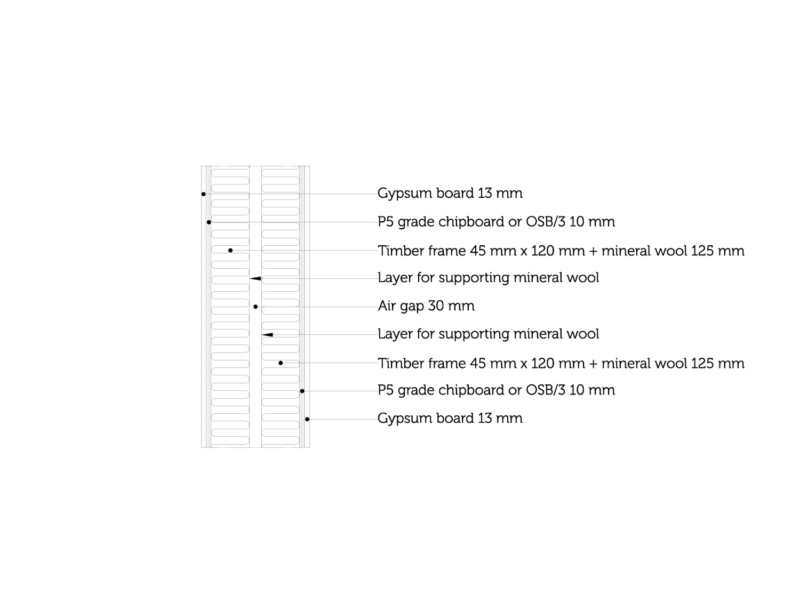External walls with masonry façade | External walls with plaster cladding | External walls with wooden cladding boards Non-load-bearing internal walls | Load-bearing internal walls | Walls between apartments
External walls
All external wall elements are insulated and the elements are covered with wooden cladding boards that have been primed once and painted once and are attached using nails. If the client does not want a house finished with wooden cladding boards, we can deliver the external walls with appropriate solutions according to the desired finishing material (plaster, masonry, etc.). The windows will be installed in the external wall elements in the factory. Only very large windows and balcony and external doors will be delivered separately. These will be installed after the basic assembly of the building has been finished.
The frame for the wall panels will be produced from grade C18 – C24 (EN 518) calibrated wood with a moisture content of 15±3%. The choice of frame for the external wall depends on the type of building, thermal insulation requirements in the country of destination and the vertical loads exerted on the wall. Generally, the thickness of the external wall’s main frame is 145 to 245 mm plus 45 mm of the additional frame. The most commonly used external wall frame is 195 + 45 mm, thus this wall has 250 mm of mineral wool.
On the inside of external walls, we use a 45 x 45 mm additional frame, which will be filled with insulating material and allows for the installation of casings and conduits for electrical cables into the external wall elements without damaging the vapour barrier. This is very important for keeping the building airtight.
Due to restrictions arising from transportation equipment and work safety rules at the construction site, the maximum length of the wall elements is 9 m and height is 2.85 m.
Heat transfer values for the external walls
| Thermal insulation, mm | U-value when Λ= 0.037 |
U-value when Λ = 0.033 |
|---|---|---|
| 200 | 0.20 | 0.19 |
| 250 | 0.17 | 0.16 |
| 300 | 0.14 | 0.13 |
External walls with masonry façade
Covering wooden frame houses with masonry façade combines two positive aspects – a wooden frame wall with good heat engineering properties will be covered with a masonry façade that gives the building a high value and long-lasting cladding. The installation of the masonry may be started immediately after the basic assembly has been finished – all wall elements, inserted ceilings and roof structures have been installed and fastened. In the case of masonry façade, it must be considered that it exerts an extra load on the foundation and that the foundation must have the necessary area for supporting the masonry. Different types of bricks may be used for the masonry façade – calcium silicate or ceramic bricks or natural stone. When building the masonry façade it must be considered that there has to remain a sufficient ventilating space between the masonry and the wooden elements. It is also important to anchor the masonry to the wooden wall.
The accompanying image shows a principal solution for an external wall with masonry façade.
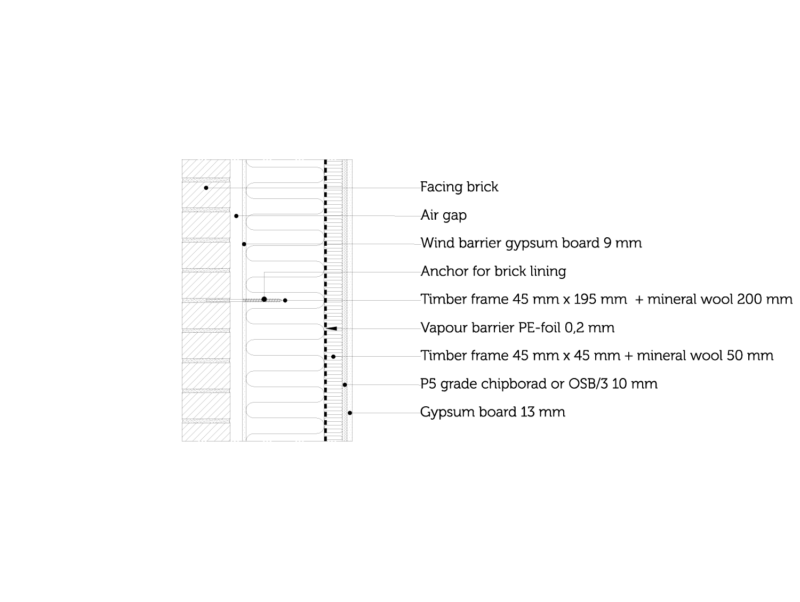
External walls with plaster cladding
Due to architectural considerations or regional construction tradition, external walls are often covered with plaster. The plasterwork on the external walls may be started immediately after the basic assembly has been finished – all wall elements, inserted ceilings and roof structures have been installed and fastened and the building has been made weatherproof. After that, a cement board for the plasterwork will be installed onto factory-installed vertical battens and the building can then be covered with plaster depending on the installation instructions for the materials used.
The accompanying image shows a principal solution for an external wall with a ventilating plaster cladding system.
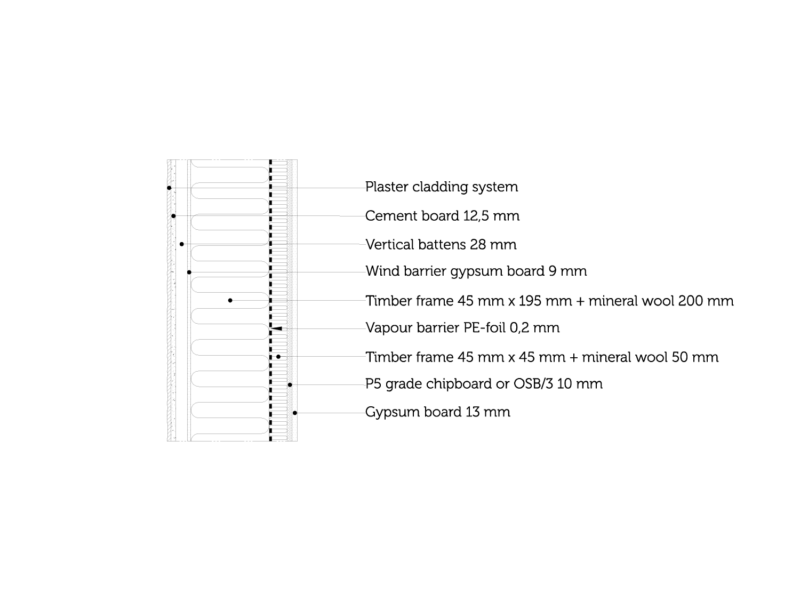
External walls with wooden cladding boards
The external walls can be covered with horizontal or vertical wooden cladding boards and vertical staggered lining or slat boarding. External wall elements with wooden cladding boards are elements with a high degree of finish because we also install the wooden window and external door reveals as well as the window sills in the factory. Following the installation of the external wall elements at the construction site, only the connections between elements and the corner connections have to be closed and covered with wooden cladding boards.
The accompanying image shows a principal solution for an external wall with horizontal cladding boards.
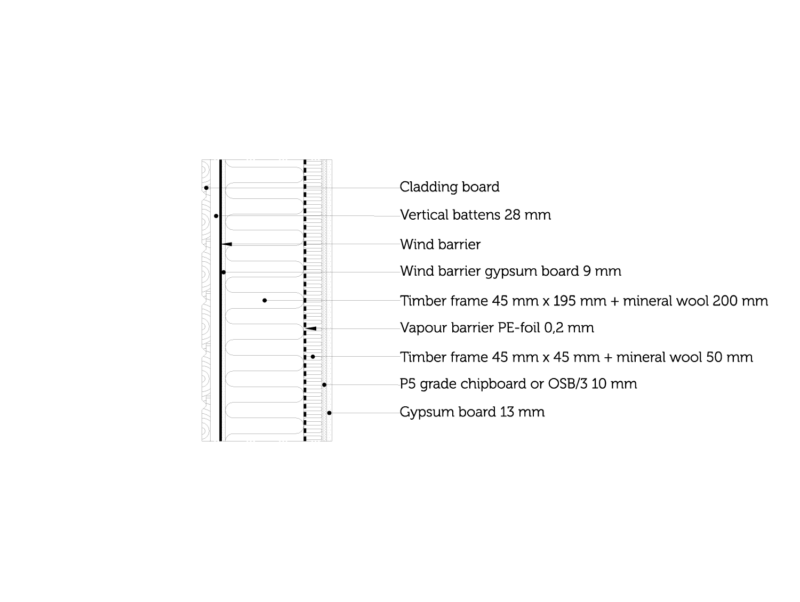
Internal walls
Our house sets include load-bearing as well as non-load-bearing internal walls and, in the case of apartment buildings or terraced houses, also walls between the apartments. Besides separating rooms from each other, internal walls give the entire building rigidity – the stability of the building is assured by connecting internal walls with external walls and inserted ceilings, which are impacted by wind load.
As standard, we use chipboard or OSB boards in our load-bearing and non-load-bearing internal walls under the outer gypsum board to give them extra rigidity. In addition to giving the building rigidity, the use of chipboard improves the acoustic insulation of the rooms and allows for the installation of shelves, cupboards or other loads on the walls. All internal walls will be filled with an insulating material, usually, glass wool, which also increases the acoustic insulation of the rooms.
In rooms for wet use, the walls will be covered with composite boards free of organic material developed especially for application in rooms for wet use (for instance Glasroc GHOE), which will later be covered on-site with hydro insulation before the installation of ceramic tiles.
Non-load-bearing internal walls
Non-load-bearing internal walls are separating walls that are self-supporting, meaning that they have not been designed to bear vertical loads.
The accompanying image shows a principal solution for a non-load-bearing internal wall.
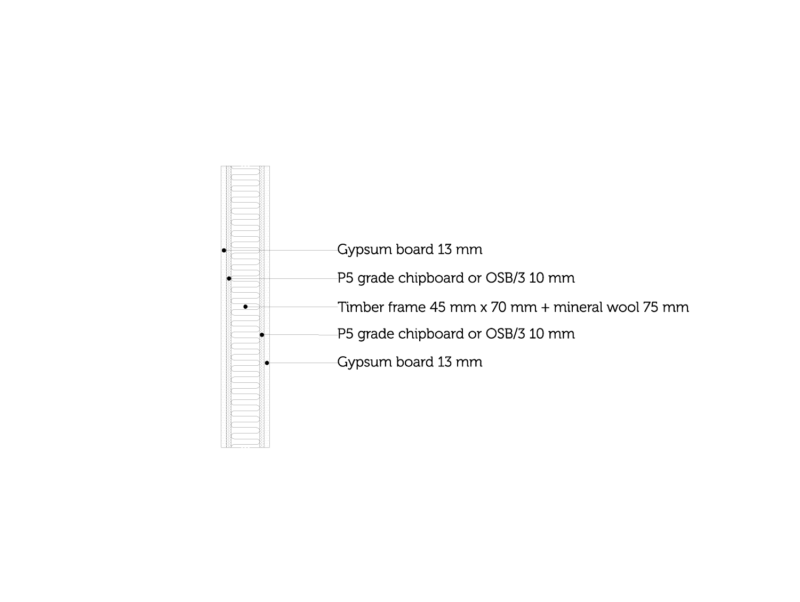
Load-bearing internal walls
Load-bearing internal walls bear the vertical load from the inserted ceiling and/or roof. The rigidity of load-bearing internal walls comes from chipboard installed on both sides of the frame, which comes as standard in our walls. The thickness of the frame for load-bearing internal walls depends on the load diagram, which is based on the architectural solution of a particular building and on the snow load at the building’s location.
The accompanying image shows a principal solution for a load-bearing internal wall.
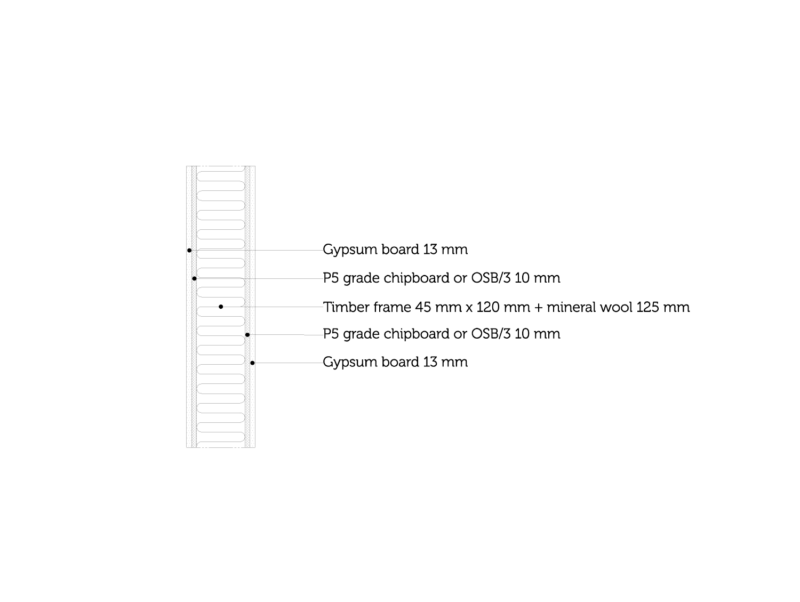
Walls between apartments
Internal walls between apartments have to meet acoustic insulation and fire safety requirements. Internal walls between apartments will be insulated with mineral wool; the number of panel layers depends on the number of floors and the fire safety requirements of the building.
The accompanying image shows a principal solution for a wall between apartments.
